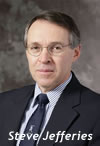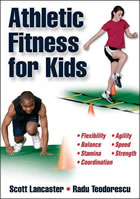EDITORIAL
Eggs
and Chickens: What's Fresh and Foul in Physical
Education?
 Every
three years the world of US physical education
teacher education (PETE)
pauses to reflect. And so last month close
to 450 professional colleagues gathered in
Las Vegas to contemplate things good and bad
in physical education. Hardly a location epitomizing
healthy and active living, the Planet Hollywood
hotel and casino nonetheless successfully
served as a comfortable venue for four days
of professional discussion and debate. Every
three years the world of US physical education
teacher education (PETE)
pauses to reflect. And so last month close
to 450 professional colleagues gathered in
Las Vegas to contemplate things good and bad
in physical education. Hardly a location epitomizing
healthy and active living, the Planet Hollywood
hotel and casino nonetheless successfully
served as a comfortable venue for four days
of professional discussion and debate.
Catching up on what's happening in the future
started the event with another PE 2020 forum.
A packed audience of early-bird attendees
gathered for 4 hours of speculating on what
physical educators might expect in both the
immediate and long term future. In 2011, NASPE's
PE 2020 initiative attracted close to 2000
visionary essays from people imagining how
PE might look in the year's ahead. Following
the San Diego convention five areas were identified
to focus on, and Vegas gave attendees the
chance to discuss progress to date and ways
to continue forward thinking and planning.
Among several of the ideas that emerged was
a suggestion that the imminent arrival of
the year 2020 didn't give us much time to
plan our professional future. Instead of a
planned and purposeful future's approach,
we tend instead to be reactive and opportunistic.
Rather than being guided by a carefully deliberated
and intentional plan, we find ourselves looking
for ways to integrate new gadgets and games
into our programs. Acting this way, we are
absolving responsibility for our future and
letting it be directed by outsiders who are
motivated to serve their own best interests
rather than ours.
Of course thinking for the long-term brings
a different set of problems. It's easy to
assume that physical education has an assured
place in tomorrow's schools. The accelerating,
and in many ways, unpredictable changes taking
place in today's world make this assumption
unwise. Public schools are going to change
much faster than most of us expect. They have
to. America is fast losing traction as the
dominant global leader. Our children must
be better prepared with 21st century skills
and knowledge. How will physical education
fit into this new landscape? That's a question
that demands much more of our attention.
The good news is that in any future world,
children will need to be physically educated.
They'll need the skills and knowledge that'll
prepare them to lead healthy and active lives.
But agreeing on this is the easy part. Sadly,
after more than a century of trying we still
can't seem to agree on what physical education
is and is not, and today it's becoming even
murkier. For a half century or more we've
debated whether physical education should
be an education of or through
the physical. Should we be focusing exclusively
on the body, or emphasizing social, emotional,
and cognitive benefits?
If that wasn't confusing enough, attendees
at the PETE conference were repeatedly confronted
with a new conundrum: Should physical education's
purpose be to contribute to physical activity,
or is physical activity the way we help people
become physically educated? While there are
good arguments for both viewpoints, if we
can't agree on what we're trying to do, what
chance do we have explaining it to others?!
It should come as no surprise that amid the
confusion we "don’t get no respect."
Reflecting the perspective of many future
thinkers, a lot of attention at the PETE conference
focused on getting physical educators involved
in physical activity promotion outside of
scheduled "gym classes." Let's Move
in School (LMIS), Comprehensive School Physical
Activity Programs (CSPAPS), and a certification
program for PE teachers to qualify as Directors
of Physical Activity (DPA) were discussed
in numerous presentations. What these all
have in common aligns with one of the pe2020
themes: Developing community connections.
Clearly physical education classes alone cannot
significantly improve children's health. The
negative impact of sedentary living and unhealthy
eating can't be overcome without a much more
concerted lifestyle changing focus.
At least two aspects of the aforementioned
programs are worthy of reflection. First,
each initiative recognizes the necessity of
expanding opportunities for children to be
physically active within and outside
the school day. Second, and from a professional
perspective significant, they challenge us
to step back and to consider redefining the
role of the public school physical educator.
If you think about this, these are potentially
profession-changing proposals. If this trend
persists, what might it mean for physical
education teacher education and for public
school physical education teaching?
In anticipation of an avalanche of "We
are busy enough and don't have time for additional
responsibilities" reader comments, what
it doesn't mean is that public school physical
educators in the future should be expected
to work harder and for longer hours. That's
an easy misperception and handy ammunition
for those who'd resist considering any role-changing
scenario. Better to think of it instead as
a new job with new expectations.
Of course transitioning into a new role would
necessitate careful thought about how it might
work, and how future physical educators would
need to develop a different skill set from
today. This switch would have repercussions
both for public school staffing and also for
physical education teacher education. It wouldn't
be easy. But then neither is it going to be
easy to solve worsening children's health
and avoiding the expensive and frightening
consequences. What we can probably all agree
upon is that doing things the way we are currently
doing them is guaranteed not to bring different
results.
What an interesting time this is for our
profession. Accelerating health care costs
are fast driving the nation to a fiscal catastrophe.
Our professional association is in transition
to some yet-to-be determined new structure
with a still undecided mission. Children's
health promoting organizations are increasingly
encroaching into what we've long considered
our unique territory: America's public schools.
And encountering the perfect storm of a national
economic meltdown and rising academic expectations,
school boards and school administrators show
little reluctance to cut physical education
programs and positions.
"What's in our professional future?"
is a question well worth ongoing and focused
deliberation.
Steve
Jefferies, publisher pelinks4u
|















 Every
three years the world of US physical education
teacher education (
Every
three years the world of US physical education
teacher education (